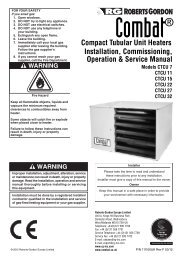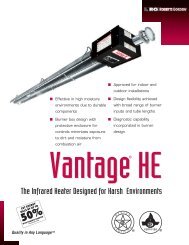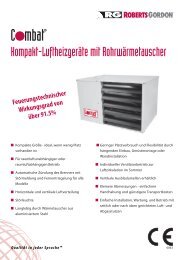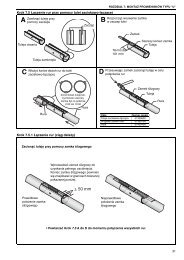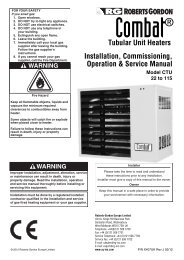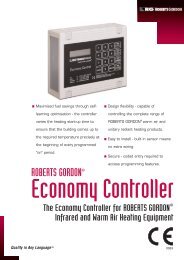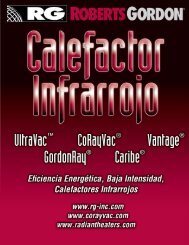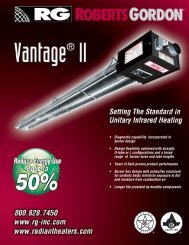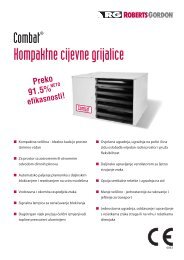Vantage Modulating - Roberts Gordon
Vantage Modulating - Roberts Gordon
Vantage Modulating - Roberts Gordon
You also want an ePaper? Increase the reach of your titles
YUMPU automatically turns print PDFs into web optimized ePapers that Google loves.
SECTION 8: VENTING<br />
SECTION 8: VENTING<br />
WARNING<br />
Carbon Monoxide Hazard<br />
Heaters installed unvented must be interlocked<br />
with sufficient building exhaust.<br />
Heaters must be installed according to the<br />
installation manual.<br />
Failure to follow these instructions can result<br />
in death or injury.<br />
WARNING<br />
Cut/Pinch Hazard<br />
Wear protective gear during installation,<br />
operation and service.<br />
Edges are sharp.<br />
Failure to follow these instructions can result<br />
in injury.<br />
8.1 Venting<br />
This heater must be vented in accordance with the<br />
rules contained in this manual and with the following<br />
national codes and any state, provincial or local<br />
codes which may apply:<br />
United States: Refer to National Fuel Gas Code<br />
NFPA 54/ANSI Z223.1 - latest revision.<br />
Canada: Refer to Natural Gas and Propane<br />
Installation Code CSA B149.1 - latest revision.<br />
Exhaust end of heater will accept a 4" (10 cm) vent<br />
pipe using the vent adapter (P/N 90502700). To<br />
prevent leakage of condensation, install the vent<br />
adapter with the seam on top and seal the joint using<br />
a high temperature silicone sealant.<br />
Any portion of vent pipe passing through a<br />
combustible wall must have an approved thimble<br />
to conform with the above listed codes.<br />
Vent pipe must be sloped downward away from the<br />
burner 1/2'' (1 cm) for every 20' (6 m).<br />
The heater may be individually vented or common<br />
vented. When venting horizontally, a maximum of two<br />
heaters can be commonly vented. See Page 33,<br />
Section 8.9. When venting vertically, a maximum of<br />
four heaters can be commonly vented. See Page 34,<br />
Section 8.10.<br />
The heater may also be installed unvented in certain<br />
circumstances according to building ventilation codes.<br />
Refer to the above codes and Page 31, Section 8.2 for<br />
further information. Unvented operation also requires<br />
compliance with the clearances to combustibles given<br />
on Page 8, Figure 12.<br />
The bottom of the vent or air intake terminal shall not<br />
be located less than 1' (.3 m) above grade level.<br />
The vent shall not terminate less than 7' (2.1 m) above<br />
grade where located adjacent to public walkways.<br />
Vent terminal must be installed at a height sufficient to<br />
prevent blockage by snow and building materials<br />
protected from degradation by flue gasses.<br />
Secure all joints with #8 x 3/8 sheet metal screws.<br />
Seal all joints with high temperature silicone sealant.<br />
Vent terminal must be beyond any combustible<br />
overhang.<br />
8.1.1 United States Requirements<br />
Vent must terminate at least 3' (.9 m) above any forced<br />
air inlet located within 10' (3.1 m).<br />
Vent must terminate at least 4' (1.2 m) below,<br />
4' (1.2 m) horizontally from, or 1' (.3 m) above any<br />
door, operable window, or gravity air inlet into any<br />
building.<br />
8.1.2 Canadian Requirements<br />
The vent shall not terminate within 6' (1.8 m) of a<br />
mechanical air supply inlet to any building.<br />
The vent shall not terminate within 3' (.9 m) of a<br />
window or door that can be opened in any building,<br />
any non-mechanical air supply inlet to any building, or<br />
of the combustion air inlet of any other appliance.<br />
8.2 Unvented Operation<br />
Sufficient ventilation must be provided in the amount<br />
of 4 cfm per 1000 Btu/h firing rate (United States); 3<br />
cfm per 1000 Btu/h firing rate (Canada).<br />
Use of optional outside combustion air is not<br />
recommended with unvented heaters.<br />
If exhaust fans are used to supply ventilation air, an<br />
interlock switch must be used to prevent the heater<br />
from coming on when the fans are off. This may be<br />
done using a pressure switch.<br />
31 of 71



